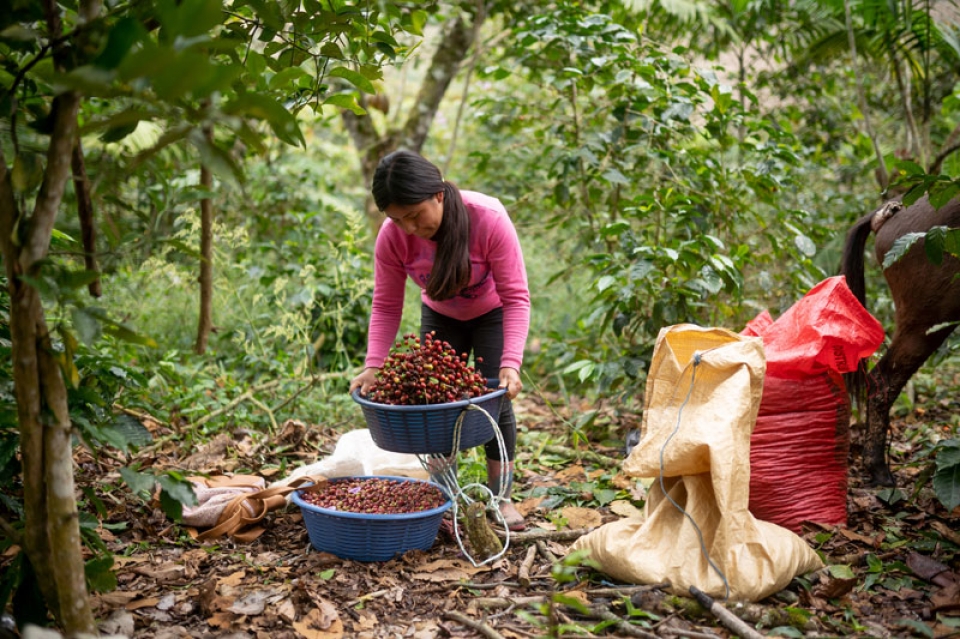New study identifies priorities for agricultural development in Guatemala | اقتصاد النظم الزراعية والغذائية | منظمة الأغذية والزراعة للأمم المتحدة
New study identifies priorities for agricultural development in Guatemala | اقتصاد النظم الزراعية والغذائية | منظمة الأغذية ... Food and Agriculture Organization of the United Nations



A Study on Microregion Typologies for Agricultural Production in Guatemala
Published by FAO as part of the Hand-in-Hand Initiative
Published on 29.02.2024
A recent study published in Spanish by FAO and entitled “Tipología de microrregiones en el sector agrícola de Guatemala: Una herramienta para priorizar inversiones en el marco de la Iniciativa Mano de la Mano” has unveiled an in-depth analysis of microregion typologies for agricultural production in Guatemala, as part of the Hand-in-Hand Initiative.
Utilizing up-to-date data on agricultural production, climate, geography, and poverty, researchers have constructed a standardized classification of territories. This classification combines the potential of national agrifood systems with the efficiency of producers to generate income in areas where poverty is prevalent.
The comprehensive study has shed light on prioritizing territories and differentiating strategies based on two key points. Firstly, each territory possesses unique characteristics, necessitating varying degrees of priority. Secondly, as a complement to the former, investment types and public policies must align with the socioeconomic dimensions and specific needs of each territory or region. This territorial prioritization is based on three components: potential, efficiency, and poverty.
- Potential: Under the stochastic frontier model framework, potential refers to the maximum incomes achievable by a producer given observed prices, climatic conditions, and land use. The study reveals that territories with high potential are more likely to benefit from short-term agricultural investments, with higher returns. Conversely, areas with low potential are clustered in specific regions, suggesting the need for focused interventions to alleviate poverty.
- Efficiency: The efficiency component measures the unrealized potential of territories, specifically the technical efficiency that reflects farmers’ abilities to exploit market opportunities given their skills and capabilities. Interventions in areas with high unrealized potential are believed to have a greater impact, as they present opportunities for closing the gap and boosting agricultural growth.
- Poverty and microregion typology: The study identifies areas characterized by efficiency, potential, poverty, and chronic malnutrition, and then overlays these layers to classify territories into seven categories. Territories with high potential and low efficiency, for instance, require focused investments in training, financial services, and organization to maximize agricultural potential.
Regarding policy and investment priorities, differentiated strategies and territorial prioritization are guided by the microregion typology categories. Concrete interventions are suggested based on the unique characteristics and conditions of each territory in terms of agricultural potential and efficiency.
These findings serve as a guide for investment and policy interventions aimed at accelerating agricultural transformation and sustainable rural development in the country. By adopting a territorial approach, decision-makers can prioritize interventions and policies effectively. However, it’s crucial to note that typology maps are just one prioritization tool among many and should be complemented with specific analyses such as value chains’ characterization, field validation, financial and fiscal viability, environmental sustainability, and inclusion in social sustainability. Moreover, discussions with local governments are essential as these results may not fully capture the intricacies within each territory or region.
Overall, this study contributes to the planning and design of investment programmes and projects for Guatemala’s agricultural sector and guides the country’s public policies. These insights are invaluable for local and national policymakers, international financial institutions, donors, civil society, private sector entities, international cooperatives, research institutes, and other United Nations agencies.
SDGs, Targets, and Indicators Analysis
1. Which SDGs are addressed or connected to the issues highlighted in the article?
- SDG 1: No Poverty
- SDG 2: Zero Hunger
- SDG 8: Decent Work and Economic Growth
- SDG 10: Reduced Inequalities
- SDG 17: Partnerships for the Goals
The issues highlighted in the article are connected to several SDGs. The focus is on addressing poverty (SDG 1) and hunger (SDG 2) through agricultural development. The article also emphasizes the need for economic growth (SDG 8) and reducing inequalities (SDG 10) in the agricultural sector. Additionally, the Hand-in-Hand Initiative mentioned in the article aligns with SDG 17, which emphasizes partnerships for achieving sustainable development.
2. What specific targets under those SDGs can be identified based on the article’s content?
- Target 1.1: By 2030, eradicate extreme poverty for all people everywhere.
- Target 2.3: By 2030, double the agricultural productivity and incomes of small-scale food producers.
- Target 8.3: Promote development-oriented policies that support productive activities, decent job creation, entrepreneurship, creativity, and innovation.
- Target 10.2: By 2030, empower and promote the social, economic, and political inclusion of all.
Based on the article’s content, the specific targets that can be identified are related to eradicating extreme poverty (Target 1.1), doubling agricultural productivity and incomes (Target 2.3), promoting development-oriented policies (Target 8.3), and empowering social and economic inclusion (Target 10.2).
3. Are there any indicators mentioned or implied in the article that can be used to measure progress towards the identified targets?
- Indicator 1.1.1: Proportion of the population living below the international poverty line.
- Indicator 2.3.1: Volume of production per labor unit by classes of farming/pastoral/forestry enterprise size.
- Indicator 8.3.1: Proportion of informal employment in non-agriculture employment.
- Indicator 10.2.1: Proportion of people living below 50 percent of median income.
The article implies indicators that can be used to measure progress towards the identified targets. The proportion of the population living below the international poverty line (Indicator 1.1.1) can measure progress towards eradicating extreme poverty. The volume of production per labor unit by enterprise size (Indicator 2.3.1) can measure progress towards doubling agricultural productivity and incomes. The proportion of informal employment in non-agriculture employment (Indicator 8.3.1) can measure progress towards development-oriented policies, and the proportion of people living below 50 percent of median income (Indicator 10.2.1) can measure progress towards social and economic inclusion.
4. Table: SDGs, Targets, and Indicators
| SDGs | Targets | Indicators |
|---|---|---|
| SDG 1: No Poverty | Target 1.1: By 2030, eradicate extreme poverty for all people everywhere. | Indicator 1.1.1: Proportion of the population living below the international poverty line. |
| SDG 2: Zero Hunger | Target 2.3: By 2030, double the agricultural productivity and incomes of small-scale food producers. | Indicator 2.3.1: Volume of production per labor unit by classes of farming/pastoral/forestry enterprise size. |
| SDG 8: Decent Work and Economic Growth | Target 8.3: Promote development-oriented policies that support productive activities, decent job creation, entrepreneurship, creativity, and innovation. | Indicator 8.3.1: Proportion of informal employment in non-agriculture employment. |
| SDG 10: Reduced Inequalities | Target 10.2: By 2030, empower and promote the social, economic, and political inclusion of all. | Indicator 10.2.1: Proportion of people living below 50 percent of median income. |
The table presents the findings from analyzing the article, listing the relevant SDGs, their corresponding targets, and the specific indicators identified in the article.
Behold! This splendid article springs forth from the wellspring of knowledge, shaped by a wondrous proprietary AI technology that delved into a vast ocean of data, illuminating the path towards the Sustainable Development Goals. Remember that all rights are reserved by SDG Investors LLC, empowering us to champion progress together.
Source: fao.org

Join us, as fellow seekers of change, on a transformative journey at https://sdgtalks.ai/welcome, where you can become a member and actively contribute to shaping a brighter future.







